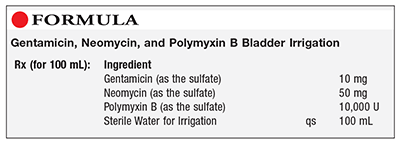US Pharm. 2014;39(8):54-55.

Method of Preparation: Note—This formulation should be prepared according to strict aseptic compounding technique in a laminar airflow hood in a cleanroom or via isolation barrier technology by a compounding pharmacist who is validated in aseptic compounding. This is a high-risk preparation.
Calculate the required quantity of each ingredient for the total amount to be prepared using the labeled potency of each ingredient. Accurately weigh or measure each ingredient. Dissolve the powders in sufficient Sterile Water for Irrigation to final volume and mix well. Sterile-filter into appropriate sterile containers. Package and label.
Use: This preparation has been used in the treatment of bladder infections.
Packaging: Package in tight, light-resistant containers.1
Labeling: Keep out of reach of children. Use only as directed. For professional use.
Stability: Refer to the current edition of the U.S. Pharmacopeia for the appropriate beyond-use date for this compounded preparation.1
Quality Control: Quality-control assessment can include weight/volume, physical observation, pH, specific gravity, osmolality, assay, color, clarity, particulate matter, and sterility.2,3
Discussion: Bladder-irrigation formulations are required to be sterile and prepared according to USP General Chapter <797> Pharmaceutical Compounding—Sterile Preparations.1 This combination of anti-infective ingredients has been used for the treatment of bladder infections that are due to susceptible microorganisms.
Gentamicin sulfate is an aminoglycoside antibiotic occurring as the sulfate salt, or a mixture of such salts, of the antibiotic substances produced by the growth of Micromonospora purpurea. Commercially, gentamicin sulfate is a mixture of the sulfate salts of gentamicin C1, C2, and C1A. It occurs as a white to buff-colored powder that is soluble in water, but insoluble in alcohol. The pH of the injection is between 3.0 and 5.5. Gentamicin sulfate has a potency equivalent of not less than 590 mcg of gentamicin per mg calculated on the dried basis. It should be preserved in tight containers.1,4
Neomycin sulfate is an aminoglycoside antibiotic that is obtained from the cultures of Streptomyces fradiae. This agent occurs as a white to slightly yellow, hygroscopic powder that is freely soluble in water and very slightly soluble in alcohol. It should be stored in tight, light-resistant containers. Neomycin sulfate has a potency equivalent of not less than 600 mcg of neomycin per mg, calculated on the dried basis.1,4
Polymyxin B sulfate is the sulfate salt of a polymyxin produced by the growth of Bacillus polymyxa. Polymyxin B sulfate occurs as a white to buff-colored, hygroscopic powder that is odorless or has a faint odor. Polymyxin B sulfate is freely soluble in water and 0.9% sodium chloride injection and is slightly soluble in alcohol. It has a potency of not less than 6,000 U of polymyxin B per mg, calculated on the dried basis. The aqueous solutions of polymyxin B have a pH ranging from 5 to 7.5.1,4
Sterile Water for Irrigation is Water for Injection that has been sterilized and suitably packaged; it contains no antimicrobial agent or other added substances. Water for Injection is water purified by distillation or by reverse osmosis; it contains no added substances. The term water is used to describe potable water from a public water supply that is suitable for drinking and is the beginning point of the official waters. It is a clear, colorless, odorless, and tasteless liquid. Purified water is water that is obtained by distillation, ion exchange, reverse osmosis, or some other suitable process. Water has a specific gravity of 0.9971 at room temperature, a melting point of 0°C, and a boiling point of 100°C. It is miscible with most polar solvents and is chemically stable in all physical states (ice, liquid, and steam).1,5
REFERENCES
1. United States Pharmacopeial Convention, Inc. U.S. Pharmacopeia 36/National Formulary 31. Rockville, MD: U.S. Pharmacopeial Convention, Inc; 2013:361-398,3720-3721,4463-4464,4826-4827,5592.
2. Allen LV Jr. Standard operating procedure for particulate testing for sterile products. IJPC. 1998;2:78.
3. Allen LV Jr. Standard operating procedure: quality assessment for injectable solutions. IJPC. 1999;3:406-407.
4. McEvoy GK, ed. AHFS Drug Information 2012. Bethesda, MD: American Society of Health-System Pharmacists; 2012:485,3487,3497.
5. Dubash D, Shah U. Water. In: Rowe RC, Sheskey PJ, Quinn ME, eds. Handbook of Pharmaceutical Excipients. 6th ed. Washington, DC: American Pharmaceutical Association; 2009:766-770.
To comment on this article, contact rdavidson@uspharmacist.com.





